
- •Welcome to Seagate Crystal Reports
- •Welcome
- •Two kinds of Hands-On tutorials
- •Command, button, key, and control conventions
- •Using Seagate Crystal Reports documentation
- •Seagate Crystal Reports online Help features
- •If you need more help...
- •Installation Requirements
- •Installing Seagate Crystal Reports
- •Installing on a network workstation
- •Upgrading from a previous version
- •Quick Start
- •Subreports expand report usefulness
- •Query Designer adds ad-hoc querying capabilities
- •Parameter fields mean multi-purpose reports
- •Text objects give you text with intelligence
- •Preprinted-form reports easier than ever
- •More powerful formulas extend your capabilities
- •Web solution serves up variety of online reports
- •HTML exporting simplifies Web activities
- •New database support improves data access
- •Running totals made easy
- •Smart Navigation
- •Learning Seagate Crystal Reports
- •User’s Guide
- •Online Help
- •Books Online
- •Sample Reports
- •Glossary
- •Sample Data - CRAZE.MDB
- •Suggested learning paths
- •The application window
- •Menu bar
- •Standard toolbar
- •Supplementary toolbar
- •Format bar
- •Status bar
- •Shortcut menus
- •Cursors
- •Design Tab
- •Preview Tab
- •Other fundamentals
- •HANDS-ON (Report Design Environment)
- •How to add, delete, and move guidelines
- •How to move and position objects using guidelines
- •How to turn the grid on/off
- •How to zoom your report in and out
- •How to undo/redo activities
- •How to drill down on summarized data
- •HANDS-ON (Sections and Areas)
- •How to add, delete, move, and merge sections
- •How to split and resize sections
- •Basic report design
- •How to design a prototype
- •Concepts in reporting
- •Beyond basic reports
- •HANDS-ON (Report Creation and Design)
- •How to select data and begin creating a report
- •How to add and link multiple tables
- •How to insert database fields
- •How to insert special fields
- •How to insert a page n of N field
- •How to insert text objects
- •How to use a database field in a text object
- •How to insert a picture
- •How to select, move, and resize objects
- •How to hide parts of the report
- •HANDS-ON (Finishing Your Report)
- •How to insert page headers and footers
- •How to add a title page to your report
- •How to add summary information to your report
- •Printing considerations
- •Design solutions for printing/distributing
- •Report creation checklist for distributed reports
- •Updating printer drivers
- •Report distribution
- •HANDS-ON (Distributing Your Report)
- •How to export reports
- •How to fax a report
- •How to request reports from a web browser
- •How to specify parameter field values
- •How to log on to a database
- •How to view plain HTML reports
- •Overview
- •Getting started
- •Record Selection
- •Grouping and sorting
- •Completing the report
- •Introduction
- •Working with Arbor Essbase data
- •HANDS-ON (Reporting on OLAP data)
- •How to create a cross-tab with Essbase data
- •Using multiple sections in reports
- •HANDS-ON (Multiple Section Reports)
- •How to work with text objects
- •How to create a form letter using a text object
- •How to format objects conditionally
- •How to print conditional messages in form letters
- •How to alternate background colors for rows
- •How to eliminate blank lines
- •How to add blank lines conditionally
- •Formatting concepts
- •Absolute formatting
- •Types of formatting properties
- •Conditional formatting
- •HANDS-ON (Absolute Formatting)
- •How to add color, shading, and borders
- •How to add/edit lines and boxes
- •How to change margins
- •How to add/delete white space between rows
- •How to set page orientation and paper size
- •HANDS-ON (Conditional Formatting)
- •How to flag values that meet certain conditions
- •Record selection
- •Group selection
- •Record selection formula templates
- •HANDS-ON (Record and Group Selection)
- •How to create a record or group selection formula
- •How to use record/group selection templates
- •How to select the top or bottom N groups
- •Sorting, Grouping, and Totalling Overview
- •Creating custom groups
- •HANDS-ON (Sorting, Grouping, and Totalling)
- •How to do a single field sort
- •How to do a multiple field sort
- •How to group data
- •How to sort records within groups
- •How to summarize grouped data
- •How to subtotal grouped data
- •How to sort based on summarized group values
- •How to create multiple levels of subtotals
- •How to group data in intervals
- •How to calculate a percentage of the grand total
- •How to create group headers
- •What are formulas?
- •Other formula conventions
- •Formula syntax
- •How formulas are evaluated - Order of precedence
- •HANDS-ON (Formulas 101)
- •How to insert a formula in your report
- •How to delete formulas from your report
- •How to copy formulas from online Help
- •How to copy formulas from one report to another
- •How to create if-then-else formulas
- •How to format text with formulas
- •How to use variables in formulas
- •How to declare a variable
- •How to assign a value to a variable
- •How to conditionally assign values to variables
- •How to use an array in a formula
- •How to use a range in a formula
- •How to use semicolons in formulas
- •How to fine tune group selection formulas
- •How to fine tune record selection formulas
- •How to debug a formula
- •Introduction
- •HANDS-ON (Advanced Totalling)
- •How to maintain running totals in a list
- •How to subtotal running totals within groups
- •How to subtotal without grouping
- •How to subtotal true A to B, A to C reports
- •Parameter field objects overview
- •Multiple parameter fields
- •Parameter field considerations
- •HANDS-ON (Parameter Field Objects)
- •How to create a parameter field
- •How to use a parameter field in a formula
- •How to respond to parameter field prompts
- •How to use wildcards with parameter fields
- •How to set a report title using parameter fields
- •How to set sort order using parameter fields
- •Graphing Overview
- •Choosing a graph or chart type
- •Where to place your graph
- •Data you can graph on
- •Before you create your graph
- •HANDS-ON (Graphing)
- •How to graph on a summary or subtotal field
- •How to graph on a details field
- •How to graph on a formula field
- •How to graph on cross-tab summaries
- •How to edit graphs using PGEditor
- •How to use the underlay feature with graphs
- •OLE Objects Overview
- •Inserting OLE objects in your reports
- •Linked vs. Embedded Objects
- •The dynamic OLE menu commands
- •OLE and the Picture command
- •General OLE considerations
- •HANDS-ON (OLE Objects)
- •How OLE objects are represented in your report
- •How to use OLE - General Overview Tutorial
- •How to insert a graphic/picture as an OLE object
- •What are subreports?
- •Unlinked vs. linked subreports
- •How subreport linking works
- •HANDS-ON (Subreports)
- •How to insert a subreport
- •How to preview your subreport
- •How to combine unrelated reports using subreports
- •How to use subreports with unlinkable data
- •Cross-tab overview
- •Cross-tab components
- •HANDS-ON (Cross-Tab Objects)
- •How to create a cross-tab object
- •How to format a cross-tab
- •How to print cross-tabs that span multiple pages
- •The Crystal Query Designer
- •HANDS-ON (Queries)
- •How to create a new query
- •How to add tables to a query
- •How to link tables and specify a join type
- •How to add fields to a query
- •How to identify unique values in a query
- •How to summarize data with aggregate functions
- •How to sort records according to field values
- •How to specify records to be included in a query
- •How to select groups to be included in a query
- •How to create an SQL expression
- •How to create a query from another Crystal Query
- •How to select a query for a report
- •How to use a parameter field in a query
- •Dictionaries Overview
- •HANDS-ON (Dictionaries)
- •How to create a new dictionary
- •How to add a data file
- •How to open an SQL or ODBC data source
- •How to link multiple tables
- •How to select tables and fields for users
- •How to add/create formulas
- •How to move fields/field headings within the list
- •How to update the location of a database table
- •How to add a new field heading
- •How to add Help text
- •How to add a graphic
- •How to create sample data for users to browse
- •How to edit an existing dictionary
- •How to convert a 3.x or 4.x dictionary file
- •How to select a dictionary for a report
- •Databases Overview
- •For additional information
- •HANDS-ON (Working With Databases)
- •How to open Access queries through DAO
- •How to open Access queries through ODBC
- •How to open Access parameter queries
- •How to set up an ODBC data source
- •How to check settings for an ODBC data source
- •How to log on to an ODBC data source
- •How to add an ODBC database table to a report
- •How to log on to MS SQL Server via ODBC
- •How to log off an ODBC data source
- •How to set up an A to B, A to C link
- •How to edit an SQL query
- •How to use an ACT! database
- •How to open the NT Event Log
- •Introduction
- •Four types of data
- •Direct access database files
- •ODBC data sources
- •Crystal Query Designer files
- •Crystal Dictionary files
- •Multi-pass reporting
- •Product support
- •Web support
- •E-mail support
- •Fax support
- •Telephone support
- •Extended technical support policy
- •Product registration
- •Product return policy
- •Product replacement policy
- •Glossary
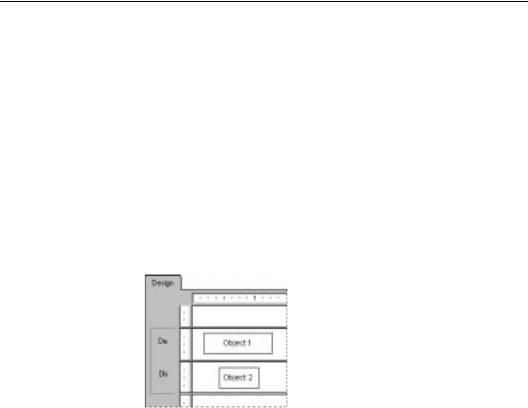
Related Topics
How to add, delete, move, and merge sections, Page 89
HANDS-ON (Multiple Section Reports)
How to prevent variable length objects from overwriting each other
When you place subreports or other variable length objects above other objects in one section of your report and you have the Can Grow option for the variable length object toggled on in the Format Editor, that object may overprint objects below it unless you have:
●expanded the section to fit the maximum size of the object, and
●spaced the objects, allowing enough space for the first object to complete printing before the second one begins. See
Types of formatting properties, Page 233.
You can eliminate this overprinting problem by creating multiple sections in an area and placing objects below the variable length object in their own section(s).
Now, when the report runs, the section with the variable length object will finish printing before the section below it prints and you will get the results you want. See TWO UNRELATED REPORTS, Page 440.
Multiple Section Reports |
215 |
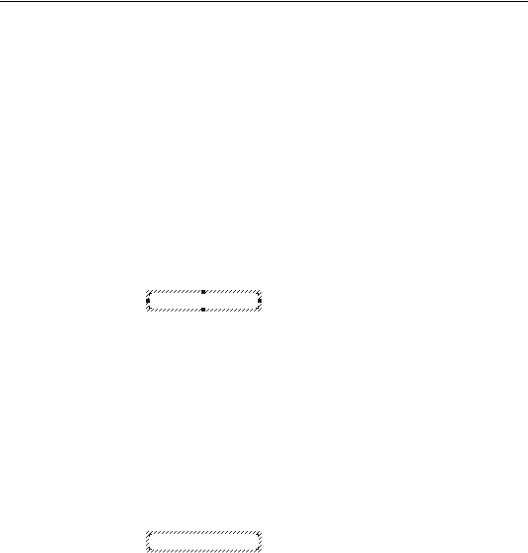
NOTE: Memo and BLOB fields, as well as subreports, can cause overprinting.
How to work with text objects
Move/Resize mode
Edit mode
You will use many of the capabilities of text objects as you create form letters. A brief discussion of text objects should make it easier for you to create the form letter in the next section.
●A text object can contain both text and fields; you will use both in this example.
●You can resize text objects; you will be resizing the text object so it prints as a letter.
Text objects operate in two modes:
1.the move/resize mode, and
2.the edit mode.
When the object is in the move/resize mode, it appears as a broken line frame with resizing handles.
In this mode, you can resize it by dragging any of the resizing handles or move it by placing the cursor inside the object and dragging it to a new location. You can also insert fields in this mode but you can not insert text. You put a text object into the move/resize mode in one of two ways:
1.by clicking the text object when it is inactive, or
2.by clicking the frame when the object is in edit mode.
When the object is in the edit mode, it appears as a broken line frame without sizing handles and with an in-place ruler at the top of the tab.
216 |
Seagate Crystal Reports User’s Guide |
When you first place a text object, the program sets it in the edit mode. You can also put a text object into the edit mode by doubleclicking it if it is inactive or in the move/resize mode.
Each text object contains word processor capabilities including the ability to change the fonts for individual characters and fields, and automatic word wrap. In the edit mode you can insert text and such non-text objects as database fields and formulas. Whenever the object is in edit mode, it contains an insertion point, a flashing vertical line that indicates the position that typed text or inserted fields will begin.
The insertion point moves as you type, automatically staying to the right of the last character. It also moves when you insert a field, automatically staying to the right of the field. It moves one character position at a time when you press the space bar. It moves down one line, to the inside left edge of the text object, when you press Enter. It moves to your cursor position when you click anywhere within the existing text.
As you work through the tutorials for multiple sections, it is always expected that you will type or place fields at the existing insertion point unless you are told otherwise.
●To select text in a text object (to delete it, to change a font, and so on), position the cursor over the text and, when the I- beam cursor appears, drag the cursor to highlight the text you want to select. See Cursors, Page 64.
●To select a field in a text object, position the cursor over the field and, when the I-beam cursor appears, right-click.
●To insert text, type in the text you want and it appears at the insertion point.
●To insert a field, you must insert it using a menu command, a button, or a dialog box. You can not simply drag a field into a text object from elsewhere in the report. When the program displays the placement frame, move the frame to the text object. The placement frame changes to a drag and drop cursor when it is in a position where the field can be inserted in the text object. See Cursors, Page 64.
Multiple Section Reports |
217 |
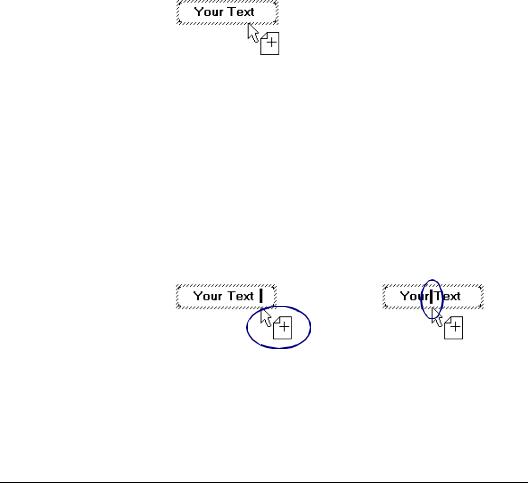
NOTE: It is critical that you see the drag and drop cursor before you place the field. If you do not see it, you might place the field so it overlays the text object instead of being inserted in it. It may appear to be inside the text object, but if you move the object the field will not move with it.
●The insertion point is tied into the drag and drop cursor. If you have existing text or fields in the text object, the insertion point moves as you move the drag and drop cursor, enabling you to pick the exact position where you want to place the field. The program always places the field at the insertion point.
As you move the drop cursor... |
the insertion point moves. |
Related Topics
How to insert text objects, Page 120
How to create a form letter using a text object
While form letters themselves are not necessarily multi-section reports, they are often used in multi-section reports to generate custom mailings. The topic, How to print conditional messages in form letters, Page 225, explains how to use multiple form letters or multiple versions of the same form letter for custom mailings. This topic shows you how to create a form letter.
You are going to use a text object to create a form letter. The form letter you create will be tied to a database table so that each letter is customized with company information from a different record.
218 |
Seagate Crystal Reports User’s Guide |
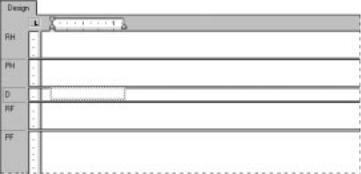
Creating the
form letter
If you have difficulty performing any of the steps in this tutorial, please see How to work with text objects, Page 216.
The letter will consist of a date, an inside address, a salutation, a one paragraph letter body, and a closing section.
Create a report using the Customer Table of CRAZE.MDB. The Design Tab appears with the Database Tab active in the Insert Fields dialog box.
Since you do not want field titles to appear above the fields that you insert into the letter, toggle the Insert Detail Field Titles option off on the Layout Tab of the File Options dialog box.
! Insert a text object in the Details section of your report.
"Click the text object frame to put the object in move/resize mode.
#Drag the resizing handle on the right side of the object to the right edge of the Design Tab. This will make the object about eight inches wide, the approximate width of a page. You may have to stop resizing, scroll the window, and resize some more to accomplish this.
Multiple Section Reports |
219 |
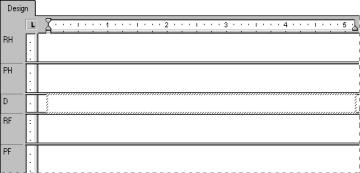
$Double-click inside the text object to place it in edit mode, ready for you to begin your work. When you do this, the insertion point will be positioned at the extreme left, inside the object.
DATE
To put a date into the letter, choose the PRINT DATE FIELD command from the Insert|Special Field menu, drag the placement frame into the text object, and place it at the insertion point.
NOTE: If you want to change the way the date is formatted in the letter, click the border of the text object to put it in move/resize mode, highlight the PrintDate field, choose FORMAT [PRINTDATE]
from the shortcut menu that appears, and make your modifications on the Date Tab of the Format Editor when it appears.
Press Enter twice to put some white space between the date and the inside address and move the insertion point down within the text object.
220 |
Seagate Crystal Reports User’s Guide |
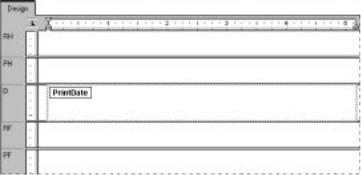
INSIDE ADDRESS
To create the inside address, drag database fields into the text object from the Customer table in the Insert Fields dialog box.
Drag in the Address 1 field, place it at the insertion point, and press Enter to place the field. The insertion point will move down to the line below.
Drag in the City field and place it at the insertion point.
! Type a comma followed by a space.
" Drag in the Region field and place it at the insertion point.
# Type in two spaces.
$Finally, drag in the Postal Code field, place it at the insertion point, and press Enter to place the field. The insertion point will move down to the line below.
%Press Enter one more time to move the insertion point down one more line to the position where you want to start the salutation. This completes the inside address.
NOTE: When you place a field into a text object, it is automatically trimmed on both the left and right sides so that it contains no extra white space.
Multiple Section Reports |
221 |
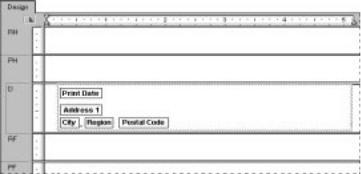
SALUTATION
Press Enter four times to move the insertion point down.
Type in the word “Dear” and a space. (Do not include the quotation marks.)
!From the Insert Fields dialog box, highlight the Contact Title field from the Customer table and drag it into the text object, placing it immediately after the space.
"Type in a space. The program positions the insertion point immediately after the space.
#Again from the Insert Fields dialog box, drag the Contact Last Name field into the text object and place it at the insertion point. The insertion point moves to the right of the field.
$Type a colon “:” at the insertion point (do not include the quotation marks) and press Enter to put in a carriage return and move the insertion point to the next line.
222 |
Seagate Crystal Reports User’s Guide |
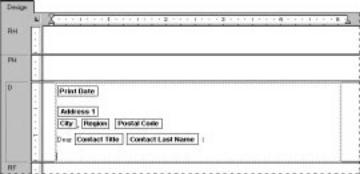
LETTER BODY
Now type “Your company” (do not include the quotation marks) and type a comma followed by a space.
Drag the Customer Name field into the text object and place it at the insertion point, just after the space.
! Type a comma followed by a space.
"Type the following text (do not include the quotation marks): “helped make 1995 an outstanding year for CRAZE Mountain Bikes. I want to thank you and your staff for your support. I hope 1996 will be a banner year for you.”
# Press Enter twice.
$Type “Sincerely yours” (do not include the quotation marks) followed by a comma, then press Enter four times.
%Finally, to complete the form letter, type your name. The Design Tab should look similar to this:
Multiple Section Reports |
223 |
